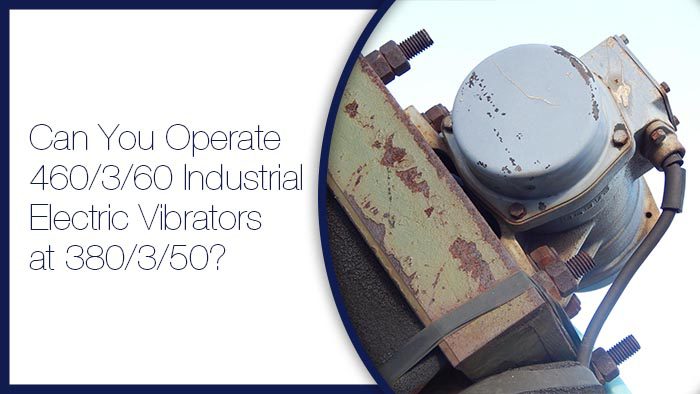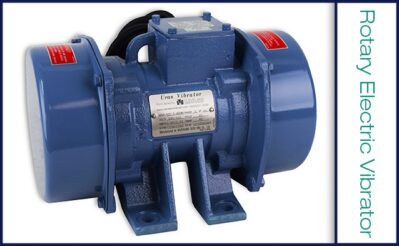I’ve noticed increased requests for operating stock U.S. rotary electric (motor) vibrators that are wound for 460/3/60 power overseas, where the power is often 380/3/50. The good news is, there are two options available to operate a rotary electric vibrator with this power rating.
First is the realization that you can operate a 460/3/60 vibrator using 380/3/50 power. It works due to de-rating the higher voltage 60 Hz motor since 50 Hz power rotates the eccentric weights at a lower RPM (rotations per minute) by a factor of 50/60. For example, an 1800 RPM vibrator would run at 50/60 x 1800 = 1500 RPM.
We can also apply this logic to voltage. So, a 460-volt motor would be de-rated to 383 volts by multiplying the 60Hz voltage by the same factor of 50/60. Therefore, due to 50Hz input, a 60Hz vibrator will accept 380 volts ± 10% without jeopardizing the motor.
Note: Due to the eccentric weights rotating at a lower RPM, the force output will experience roughly a 30% decrease.
The exact amount of reduction is the square of the factor provided above for determining the lower RPM of the vibrator due to 50Hz.
For example, if the maximum centrifugal force at 60Hz is 1,000 lbs, you need to multiply it by (50/60)² or 1,000 x 0.6944 = 694.4 lbs F (Force) when operating at 50Hz. Conversely, if your application requires 694.4 lbs F at 50Hz, the inverse of the previous factor applies or (60/50)². So, to result in 694.4 lbs F when operating at 50Hz, it requires 694.4 x 1.44 = 1,000 lbs F for 60Hz.
Now that we’ve cleared that up, you may wonder if there is any way to recover the loss in force output due to 50Hz, so you don’t have to upsize the 60Hz vibrator accordingly? The answer is yes. But, only if you are willing to use a VFD (variable frequency drive) to control your vibrator, which is the second option.
You will find that most VFDs offer a range of input voltages, so I’ve found that typical 480-volt models will accept a range of 380 to 480 input voltage, and it can be 50 or 60Hz. You can therefore input 380/3/50 to the VFD, and it will output 380/3/50 to the vibrator. We’re still good as we’ve established that the 460/3/60 vibrator will run off of 380/3/50 power.
So what about the force output?
Suppliers recommend upsizing the VFD to allow you to set the VFD at 60Hz. For example, upsizing from 1 HP to 2 HP is presumably due to the higher amp draw at 380 volts. In doing so, it will now rotate the eccentric weights of the 460/3/60 vibrator at its full rated speed and therefore produce its maximum rated force output. Ultimately, an upsized VFD will allow you to run off 380/3/50 power without losing 30% of the force output.
Lastly, some motor vibrator manufacturers have begun offering vibrators that will accept either 380/3/50 or 460/3/60 power without affecting the maximum force output.
Instead, two scale plates adjust the eccentric weights, one for 50Hz and one for 60Hz. It follows the same logic above as the eccentric weight setting compensates for the loss in force due to the slower RPM when operating at 50Hz. Essentially, the eccentric weights set at 100% on the 50Hz scale would equate to roughly 70% (69.44 to be precise) at 60Hz, but it will be set as 100% on the 60Hz scale. So the vibrator has the same maximum centrifugal force output regardless of whether you operate with 380/3/50 or 460/3/60 power.
You now have the answer with options that will allow you to utilize stock 460/3/60 vibrators internationally where 380/3/50 power is available, including the technical explanation to back it up so you can enlighten others who may be skeptical. Use your power wisely, my friends!

Jack Steinbuch has been with The Cleveland Vibrator Company for over 36 years accumulatively. He has previous experience in the manufacturing industry as a Senior Application Engineer and has worn many hats on our team in sales and managerial capacities. Now, he’s in the position of General Sales Manager. With a BSCE from The University of Toledo, he is an expert in the realm of sizing vibratory screeners and feeders, and sizing vibratory drives for tables and other vibratory equipment. Understanding that customer service is crucial, Jack believes it is important to provide the proper product for every application, even if it happens to not be supplied by The Cleveland Vibrator Company.
In his off-hours, you can find Jack spending time with his family and playing with his grandchildren. He loves sports; both watching and playing, and is an avid golfer and a league bowler during the winter. He will be retiring at the end of September 2021 and hopes to spend his winters vacationing in Florida.
Follow us:
Share this blog post:



